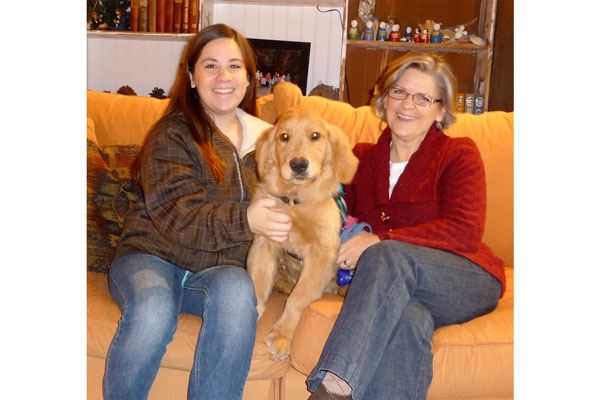How many commands did you know by the time you were 2 years old? 105?
Probably not — but that’s the standard for the charges of Wendy Bonham and Cami Bonham-Parker, her daughter.
Through their new business At Your Service Dogs, the women are training their first service dogs since they received them in late September. Bonham has first-hand knowledge of service dogs — her autistic son has had one for several years.
“We can train service dogs for lots of disabilities but we focus in on mobility, post-traumatic stress syndrome and autism,” said Bonham. “We’ve also contracted with Good Dog Autism, a program in California, to train a dog for a child in the Seattle area.”
Bonham speaks enthusiastically about the process of taking an 8-week-old puppy, all paws and play, to a thinking and working 2-year-old dog who can be the hands, legs or emotional support for their people.
“It’s a lot of obedience training but it’s much more than that. For example, for someone with a mobility issue, we teach the dog not to pull hard. We teach them to be more polite,” Bonham said. She added, “We don’t use an aversive training or techniques at all so the dogs do commands because they really love their person.”
Sitting at her kitchen table, Bonham is accompanied in conversation by the rhythmic thump, thump, thump of a puppy’s tail on the floor. It’s 8-month-old Midas listening in. She quickly redirects the teething pup from her chair leg to a nylon bone with some reassuring petting. Midas, a golden retriever, came from a breeder who had taught him to sit by the time he was 8 weeks old. He’d also met 100 people and walked on seven different surfaces, Bonham said. He will be trained as an autism dog. Bonham also is training Bailey and her daughter is training Elly Mae, who are sisters, for either mobility or post-traumatic stress disorder.
“For a mobility service dog, we teach them to turn on or off lights, to open the fridge and get something out of the fridge, to open cupboards. One of my dogs I’m hoping to train for a friend with balance issues, which is hardest to train for because the dogs have to be really steady and learn to brace a person much heavier than they are,” Bonham said.
She explained an autism service dog is trained for a completely different purpose. For example, people with autism tend to want to run, so the dog is taught to stop dead in its tracks when there’s too much motion going on.
“Another thing is socialization. It’s amazing how the dogs bring the kids out. They’re a bridge to social skills,” Bonham said. “It’s amazing to see the changes you can see in kids — they’re showing care and they learn to have that emotional connection. They’re seeing outside of their own little world.”
Bonham-Parker added, “Sometimes people with autism don’t like to be touched but they and their dogs have bonded very well together.”
The unconditional love and acceptance from the pups also has a visible calming effect on one of their dog walkers, a man with PTSD.
“You can physically see his body change and relax,” Bonham said.
Some of the commands for PTSD and autism would include snuggle, lap, touch and visit.
Before Midas, Bailey and Elly Mae could be trained, the mother-daughter team had to be trained themselves. Both attended an intensive course at Bergin University for Canine Studies in Rohnert Park, Calif., which covered the gamut from how to teach commands to assessing potential clients’ suitability for their dogs. They also learned how to read each individual dog’s personality.
“You want to have a dog who’s more interested in people than in other dogs,” Bonham said. “That’s a big one — loyalty. You don’t want them to be too excitable. Service dogs are supposed to be unobtrusive. You want dogs that are teachable and have a low prey drive. Typically, service dogs are golden retrievers and labs.”
“We look for more childlike personalities and goldens and labs stay puppy-like,” Bonham-Parker said.
“They enjoy learning. With the puppy I’m training, it’s ‘What can I do next for you?’ Midas is really playful, really smart, and he’s amazing in how quickly he catches on,” Bonham said. “He learned ‘leave it’ in one day. It’s amazing to me how much they want to learn — they thrive on learning. It’s confidence building for them.” The three pups know 39 commands individually already and train for an hour at a time several times throughout the day.
Midas will stay with Bonham until he’s 1 year old, but Bailey and Elly Mae won’t be released to their new families until they are 2 years old when they’re more mature, which raises the question, how can the women give them up?
“How can we give them away? To me, I love them and will have a loss but knowing that a person will have joy and a better quality of life and Midas will have a good quality of life and be happy is what makes it OK. I’m excited about the opportunities for both the dogs and the people,” Bonham said.
“It’s seeing what they actually do for someone with PTSD,” Bonham-Parker said, that makes it all worthwhile.



